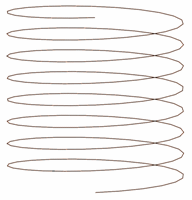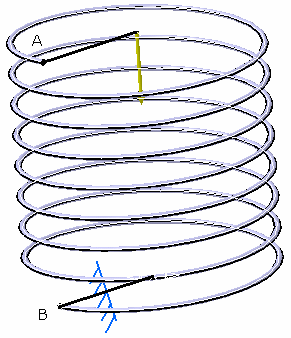This test lets you check the rigidity of a cylindrical coil spring clamped at an extremity and submitted to a longitudinal force. You will use 1D and 3D models.
Reference:
Analytical solution
 Specifications
Specifications
Geometry Specifications
|
Spring height: h = 40 mm Coiling diameter: D = 40 mm Wire diameter: d = 0.9 mm Number of turns: i = 8 |
|
Analysis Specifications
|
Young Modulus (material): |
|
|
Poisson's Ratio (material): |
|
|
Mesh Specifications:
|
|
|
Restraints: |
|
|
Loads: |
 Results
Results
Analytical solution
For an acute angle of inclination of turns (Where:
G: shear modulus
![]()
For ![]() = 7.13°
= 7.13°
![]()
Computed results
You may get the same stiffness as previously using the formula:The table below presents the analysis results:
|
Models |
Maximum displacement on z [mm] |
Experimental k [N/m] |
Normalized results |
|
1D |
2.399 |
4.168404 |
1.001058 |
|
3D |
2.52412 |
3.961777 |
0.951435 |
To Perform the Test:
The spring_1d.CATAnalysis document presents a complete analysis of this case.
The spring_3d.CATAnalysis document presents a complete analysis of this case.
To compute the case, proceed as follow:
-
Open the CATAnalysis document.
-
Compute the case in the Generative Structural Analysis workbench.
-
Create a global sensor (Maximum displacement) and a local sensor (Displacement vector).

